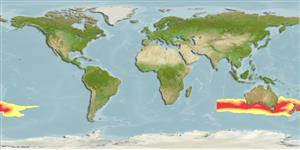Klassifizierung / Names
Namen | Synonyme | Catalog of Fishes(Gattung, Arten) | ITIS | CoL | WoRMS | Cloffa
Elasmobranchii (Haie und Rochen) (sharks and rays) >
Carcharhiniformes (Ground sharks) >
Scyliorhinidae (Cat sharks) > Scyliorhininae
Etymology: Cephaloscyllium: cephalus, from kephale (Gr.), head, referring to its very broad and depressed head; skylion, Greek for dogfish or small shark. (See ETYFish); albipinnum: albus (L.), white; pinna (L.), fin, but used here as a neuter adjective (finned), referring to distinctive white margins on fins. (See ETYFish).
More on authors: Last, Motomura & White.
Environment: milieu / climate zone / depth range / distribution range
Ökologie
seewasser bathypelagisch; tiefenbereich 126 - 554 m (Ref. 76947). Temperate
Indo-West Pacific: Southern part of Australia.
Size / Gewicht / Alter
Maturity: Lm ? range ? - ? cm
Max length : 101 cm TL Männchen/unbestimmt; (Ref. 76947); 102.5 cm TL (female)
Kurzbeschreibung
Morphologie | Morphometrie
A large species with the following characters: head 8.6-13.5% TL in height, trunk 16.1-23.8% TL in width; origin of first dorsal-fin usually forward of mid pelvic-fin base; prenarial 4.5-5.1% TL in length; length of preorbital snout 1.4-1.7 times prenarial length, 2.5-3.1 in prepectoral length, 6.3-6.9 in pre-pelvic length; snout-vent long, its length 48.1-52.4% TL; width of nostril 2.4-2.7% TL; eye-spiracle space wide, 1.0–1.4% TL; pectoral fin large, its height 12.6-13.6% TL, posterior margin 12.0-13.6% TL in length; anal fin tall, height 3.8–4.4% TL; anal-caudal space 4.0-5.6% SL; precaudal length 74-78% TL; interdorsal space 6.3-7.6% TL; teeth with 3-5 cusps near symphysis of upper jaw; mainly weak tricuspidate flank denticles; back without greatly enlarged denticles; long adult clasper, up to 8.8% TL, almost reaching anal fin, interspace about 4.4 in anal-fin base; vertebral centra 121-126; tooth count high, each jaw with 90-116 teeth; strong pattern of saddles and blotches on upper half of body; dark, transverse dorsal markings (9-10) on body and tail, interspaces between are narrow; interspiracular saddle subequal to eye and spiracle length; over and above gill slits with large circular blotch; fins with variably developed, narrow pale margins (Ref. 76947).
Life cycle and mating behavior
Geschlechtsreife | Fortpflanzung | Ablaichen | Eier | Fecundity | Larven
Last, P.R., H. Motomura and W.T. White, 2008. Cephaloscyllium albipinnum sp. Nov., a new swell shark (Carcharhihiformes: Scyliorhinidae) from Southeastern Australia. In Last, P.R., White, W.T. & Pogonoski, J.J. (eds.): Descriptions of New Australian Chondrichthyans. CSIRO Marine and Atmospheric Research Paper no. 22. (Ref. 76947)
IUCN Rote Liste Status (Ref. 130435)
Bedrohung für Menschen
Harmless
Nutzung durch Menschen
Mehr Information
NamenSynonymeMetabolismusRäuberÖkotoxikologieFortpflanzungGeschlechtsreifeAblaichenSpawning aggregationFecundityEierEientwicklung
Alter/GrößeWachstumLänge-GewichtLänge-LängeLängenhäufigkeitenMorphometrieMorphologieLarvenLarven Pop.Dyn.RekrutierungDichteBRUVS
ReferenzenAquakulturAquakultur ProfilZuchtlinienGenetikElectrophoresesVererbbarkeitKrankheitenVerarbeitungNutrientsMass conversion
PartnerBilderStamps, Coins Misc.LauteCiguateraGeschwindigkeitSchwimmstilKiemenoberflächeOtolithsGehirngrößeSehfähigkeit
Tools
Zusatzinformationen
Download XML
Internet Quellen
Estimates based on models
Preferred temperature (Ref.
123201): 10.9 - 15.1, mean 12.6 °C (based on 44 cells).
Phylogenetic diversity index (Ref.
82804): PD
50 = 0.5000 [Uniqueness, from 0.5 = low to 2.0 = high].
Bayesian length-weight: a=0.00263 (0.00139 - 0.00497), b=3.21 (3.04 - 3.38), in cm total length, based on LWR estimates for this (Sub)family-body shape (Ref.
93245).
Trophic level (Ref.
69278): 4.2 ±0.5 se; based on size and trophs of closest relatives
Widerstandsfähigkeit (Ref.
120179): niedrig, Verdopplung der Population dauert 4,5 - 14 Jahre. (Preliminary K or Fecundity.).
Fishing Vulnerability (Ref.
59153): High vulnerability (62 of 100).
